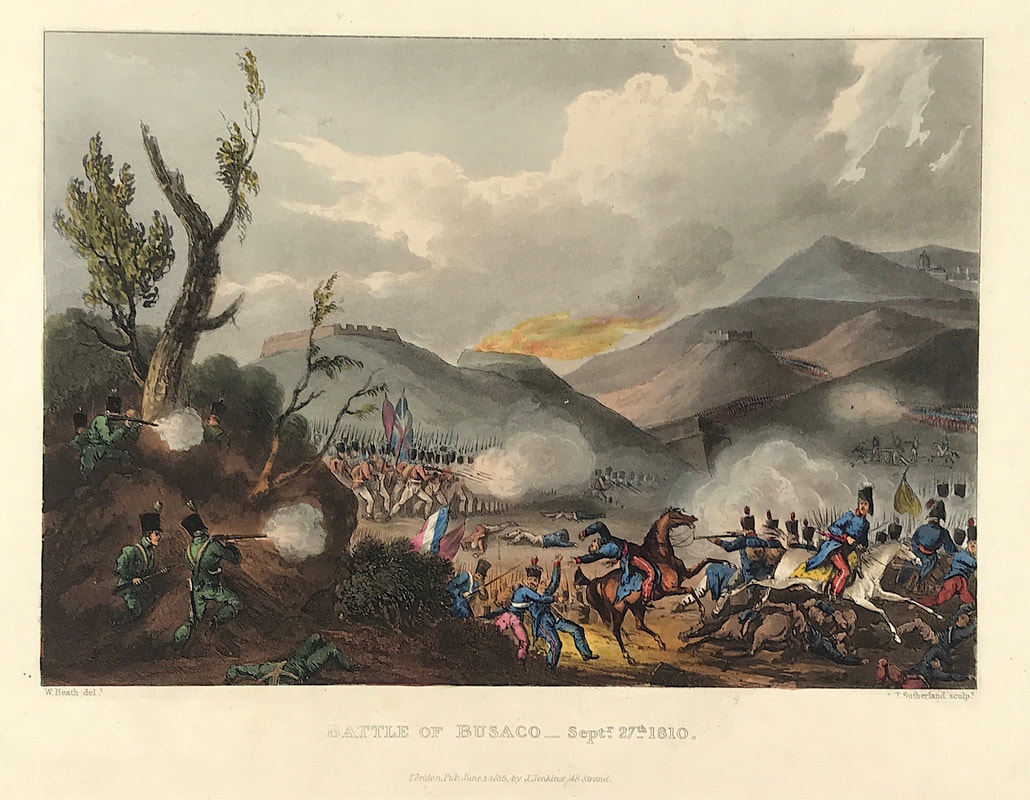|
Another print from Jenkins The Martial Achievements of Great Britain and Her Allies from 1799 to 1815. Below the print is a short excerpt from the original written account as published with the print. The Battle of Buçaco or Bussaco, fought on 27 September 1810 during the Peninsular War in the Portuguese mountain range of Serra do Buçaco, resulted in the defeat of French forces by Lord Wellington's Anglo-Portuguese Army. Wellington's preparations for a defensive battle along the line of the Buçaco ridge had extended as far as the construction of a lateral communications road behind the crest. Although Wellington's forces were concentrated at the likely points of attack within the northern half of the 16km-long ridge, the communications road allowed troops to be moved quickly from one point to another. Above: Battle of Busaco, Sept 27th, 1810. London Published June 1st 1815 by J. Jenkins, 48 Strand. From The Martial achievements of Great Britain and Her Allies from 1799 to 1815 by James Jenkins.
Excerpt from the written account as published: THE BATTLE OF BUSACO, SEPTEMBER 27, 1810. THE Sierra de Busaço is a high ridge which extends from the Mondego in a northerly direction about eight miles, upon the highest point of which, about two miles from its termination, are the convent and garden of Busaço. The Sierra de Busaço is connected by a mountainous tract with the Sierra de Cara. The roads are all very difficult of access to an army, the approach to the top of the ridge being rugged and intersected. It was here the British army completely discomfited the forces of Massena. At six in the morning of the 27th of September, according to the Gazette Extraordinary of October 15th, the enemy made two desperate attacks upon our position, the one on the right, the other on the left of the highest point of the Sierra. The attack upon the right was made by two divisions of the 2d corps on that part of the Sierra occupied by the 3d division of infantry. One division of French infantry arrived at the top of the ridge, when it was attacked in the most gallant manner by the 88th-(see the Plate)-under the command of the Hon. Lieutenant-Colonel Wallace, the 45th under the Hon. Lieutenant-Colonel Meade, and the 5th Portuguese under Lieut.-Colonel Douglas, directed by Major-General Picton: these three corps advanced with the bayonet, and drove the enemy's division from the advantageous ground which it had obtained. The other division of the 2d corps attacked farther on the right, by the road leading to St. Antonio de Cantaro, also in front of Major-General Picton's division: this division of the enemy was repulsed, before it could reach the top of the ridge, by the 74th regt. under the Hon. Lieutenant-Colonel Freaeh, and the brigade of Portuguese infantry under Colonel Champelmond, directed by Colonel M'Kinnon. Major General Leith also moved to his left, to the support of Major-General Picton, and aided in the defeat of the enemy in this quarter with the 3d bat. of royals and the Ist and 2d batts. of the 38th. In these attacks Major-Generals Leith and Picton, Colonels M'Kinnon and Champelmond of the Portuguese service, the latter of whom was wounded; the Hon. Lieutenant-Colonels Wallace and Meade, Lieatenant-Colonel Sutton of the 9th Portuguese, Major Samith of the 454h (hiled), Lieut. Colonel Douglas and Major Birmingham of the 8th Portuguese legion, greatly distinguished themselves. Major-General Picton reports in handsome terms of the 0th and 21st Portuguese regts. commanded by Lieutenant-Colonels Sutton and De Arouje Bacellar, and of the Portuguese artillery commanded by Lieutenant-Colonel Arenschild. Particular mention is also made of the conduct . . . How to Identify the Prints: The original prints from The Martial achievements of Great Britain and Her Allies from 1799 to 1815 are aquatint engravings on a medium weight wove paper. Plates also exist that were printed on India Paper. They should clearly identify bottom left W. Heath (delt) who did the drawings and bottom right T. Sutherland (sculpt) who produced most of the aquatint engravings with some by D. Havell, M. Dubourg and J. Hill. Each plate has the date of publication and the name of the publisher beneath the engraved title. The approx engraved area of the plates are 8.5" x 7.75" (215mm x 195mm) including the engraved title text. Engraved plate mark area is approx 8.5 x 11.75 (215mm x 300mm). The large sheet size is approx 11.5" x 14" (290mm x 355mm). You can see more prints from Jenkins The Martial achievements of Great Britain and Her Allies from 1799 to 1815 HERE. If you're interested in a specific print and you cannot see it on my website please feel free to message me. |
LEARN ABOUT MAPS Where to Start? The Paper Earliest Maps Whats on the Paper? Rectum & Recto Marketing Devices Why Changing Faces? What is Ornamentation? Why all those lines? The Embellishment Story Illogical Prices Explained A Reference Library CLICK THE BOOK
Get the FREE Guide!
COLLECTING MAPS
Size Matters! Celestial Maps Strip Road Maps Sea Charts On the River of Life Projections The Sea Monsters Thematic Maps Town Plans Buy with Confidence. . .
More Top Tips for the Novice. Click the book to find out more . . .
COLLECTING PRINTS
Views of River Thames
Views of London Shipping & Craft Meet the Fairies Maritime Naval Military Battles Botanical Historic Churches Historic Views of Rome Archives
May 2024
|



